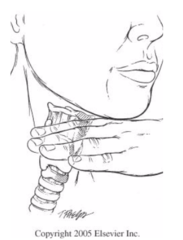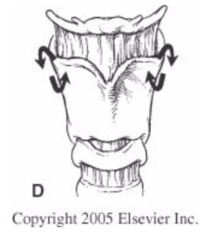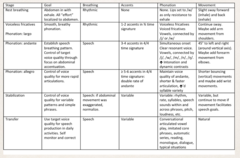Voice Treatment – Flashcards
Unlock all answers in this set
Unlock answersquestion
The patient's _________ and _________ are more important than the medical diagnosis.
answer
The patient's *body awareness* and *personality* are more important than the medical diagnosis.
question
General tips for voice therapy
answer
- there is no cookbook or recipe - you cannot use one technique exclusively - have a large toolbox and be willing to use many tools
question
When do you use manual techniques?
answer
*Primary and secondary muscle tension dysphonia* - When the severity of the dysphonia is greater than you would expect based on vocal fold visualization - when the patient is reporting pain or discomfort
question
4 goals of manual techniques
answer
1. Decrease extrinsic laryngeal muscle tension 2. Perturb the larynx so that patients can no longer use their habituated patterns to produce voice 3. "Unload" the larynx 4. Improve voice quality
question
3 main manual techniques
answer
1. Pushback 2. Lower &/or compress thyroid cartilage 3. Circumlaryngeal massage
question
1. Pushback

answer
Hyoid Thyrohyoid space Thyroid notch Anterior cricoid ring
question
3. Circumlaryngeal massage

answer
Lateral and superior border of the thyroid cartilage Often combined w/ lowering
question
How to administer manual techniques
answer
1. Try maneuver and ask patient to say a vowel (e.g., /u/). Give a strong model. 2. When there's a better voice, say "That's right", "just like that", and "do it again." 3. Continue with maneuvers that are working, add counting and phrases (e.g., /u/ 1, /u/ 2, /u/ me, moon, mean, one moon) 4. Move through the hierarchy until the patient is using their target voice consistently, then fade the maneuver.
question
Semi-occlusions =
answer
narrowing
question
SOVT =
answer
Semi-occluded vocal tract therapies
question
SOVT Techniques
answer
- straws - covering the mouth - lip/tongue trills - bilabial fricatives - humming - twang - y-buzz - resonant voice therapy - Lessac-Madson Resonant Voice Therapy (LMRVT) - Vocal function exercises
question
Physiology behind SOVT
answer
First, vocal folds "barely touch", which normalizes the closure pattern... Then, this pattern minimizes Ps needed to produce voice and minimizes vocal fold impact stress. *When this is matched w/ a neutral epilarynx, efficient voice is produced.*
question
Does resonant voice produce (more/the same/less) amplitude of vibration? Why does this matter?
answer
Resonant voice produce *the same (or possible less)* amplitude of vibration. This matters because it's a safer way to produce voice w/ full breath b/c the tissue contact force is either the same or less as in regular voicing.
question
People who work in resonant voice
answer
Theater: - Arthur Lessac SLP: - Kittie Verdolini Abbott, PhD - Mara Behlau, PhD - Linda Lee, PhD - Kate Devore
question
Resonant therapies in children
answer
*1. Establish the target: easy in the throat, buzzy in the mouth. Practice at different pitch and loudness levels.* Goals = fine-tune the hum; help children accurately judge and trouble-shoot *2. move towards phonation??* There is no correct hierarchy, but you can try this: - Non-word scripts - Resonant syllables - Resonant phrases - Functional phrases - Short, partially scripted answers - Story telling
question
LMRVT (The Verdolini Version)
answer
Focus: - feel vibration in the front of the mouth - produce "easy" voicing Framework: - hygiene "light", as relevant - deactivation followed by selective activation - hierarchical sequence Training principles: - single focus - introspective and perceptual - attention to detail - exploratory (not prescriptive) with flexible troubleshooting - use your own tools and techniques to ignite the therapy and change
question
Resonant voice is a...
answer
continuum.
question
LMRVT Hierarchy
answer
1. "Basic training gesture" (BTG): prolonged resonant sound in the conversational pitch range. - BTG is used to train target voice in detail - After established, vary via scales, music, etc. 2. Resonant voice chant (RV chant) - voiced, voiced-voiceless, add pitch/loudness changes 3. RV vocal communicatory (listener responses) 4. RV minis (online voice pull-outs) 5. RV "messa di voce" (loudness chnage) 6. Conversation (quiet room, over background noise) 7. Emotional conversation, other speaking requirements
question
People of vocal function exercises
answer
Joseph Stemple, PhD, CCC-SLP - based on the work of Bertram Briess Also: - L Lee - S Gorman - N Roy - D Nguyen - G Pasa - P Carding
question
General concepts of vocal function exercises
answer
*An exercise program that rebalances the subsystems of voice production.* - Focus on voice 2x/day - Focus on effort balance - Easy to track change and compliance - Patients often buy into it
question
How to perform vocal function exercises
answer
- Each production is done 2x - Whole program is done 2x/day - All exercises are produced w/ an "extremely forward" voice - All productions are produced as quietly as possible while still engaged (i.e., not breathy) - Patient charts progress at each practice session - Once goals are achieved, decrease frequency w/ each taper lasting at least 1 week
question
4 vocal function exercises
answer
*1. Warm up: sustain /i/ as long as you can (F above middle C for women; F below middle C for men)* Goal: length of longest /s/ *2. Stretching: Glide from lowest to highest note on "knoll", "whoop", or trills* Goal: smooth voice w/ no breaks *3. Contracting: Glide from comfortable to lowest note on "knoll", "whoop", or trills* Goal: smooth voice w/ no breaks *4. Power notes: sustain the sound "oll" (knoll w/o the kn) for as long as possible on C, D, E, F, G (middle C for women/children; octave below for men). Goal: length of longest /s/ ***Step 4 is supposed to be produced w/ an open pharynx and constricted/buzzing lips. Patients should avoid voice breaks or breathiness or strain. This is thought to train abdominal breathing, posture for vowel, and easy onsets.
question
Are we really training breath support in vocal function exercises?
answer
Probably not. Instead, we're probably training efficiency in the system.
question
Who benefits from vocal function exercises?
answer
1. People w/o voice problems 2. Benign lesions 3. Muscle tension dysphonia 4. Presbylaryngis 5. Children
question
PhoRTE
answer
- hybrid of LSVT and VFEs - developed to improve respiratory and laryngeal strength to combat sarcopenia in older adults - Works as well as VFEs (and might decrease patient-perceived effort better than VFEs) Samlan opinion: no evidence it improve strength or combats sarcopenia; be careful not to induce hyperfunction or pain
question
PhoRTE exercises
answer
1. Loud maximum sustained phonation on /a/ (do 8x) 2. Loud ascending and descending pitch glides over the entire pitch range on /a/ (do 8x) 3. Participant-specific functional exercises using a loud and high voice (do 8x) 4. Phrases from #3 in a loud and low voice (5 phrases 2x each) ***Low abdominal breathing gestures are encouraged ***Feedback is only on maintaining a "strong" voice ***Expect patients to maintain 80-90 dB SPL, as measured by a SLM at a distance of 30 cm
question
Samlan's instructions for PhoRTE exercises
answer
- complete the exercises 2x/day - feel the air flow through your throat and allow the sound to ring out; avoid feeling as if you're pushing the sound out of your throat - if it hurts or fatigues your voice, back off the effort; if it continues to hurt, stop doing the exercises and go see your SLP
question
Basics of CTT
answer
- relatively new approach - developed by Jackie Gartner-Schmidt - based on Clear Speech - somewhat follows Behrman ; Haskell (2013): pausing, visual connection, clear vowels, vocal variety, physical connection
question
Why is CTT needed?
answer
- traditional hierarchy is challenging and time-consuming - people drop out before getting to conversation - traditional therapy violates motor learning theory - words/phrase lists are not contextually relevant
question
Theory behind CTT
answer
- activates all components of a skill at the same time - training tasks are the same as real-life tasks - we want to transfer to real life for long-term change in motor performance
question
Length of CTT therapy
answer
3-4 sessions
question
Components of CTT
answer
1. Clear speech 2. Negative practice 3. Embedded BTG 4. Prosody 5. Pauses
question
1. Clear speech
answer
- let's have a conversation; you pick the topic - use crisp clear consonants and precise articulation
question
2. Negative practice
answer
- after 30 seconds of clear speech, "go back to your normal way of talking" - after another 30 seconds of normal talking, "go back to crisp clear consonants" - "do you produce 2 different voices?" Negative practice continues throughout tx: - patient is in charge of change and is less reliant on SLP feedback - this is thought to be key for self-efficacy
question
3. Embedded BTG
answer
- use the crisp clear voice and hold out buzzy consonants, particularly /m/, /n/, /v/, and /z/ - notice how they feel in the mouth - fine-tune the clear speech by noticing how the ends of sounds feel in the mouth
question
4. Prosody
answer
- increase variability to stress words and phrases - use pitch and loudness changes - "project with clarity" (focus on sensation in the mouth) - maybe slow down to allow vowels to carry the sound
question
5. Pauses
answer
- replenish breath - focus on hearing and feeling sounds at the ends of phrases - decrease pitch at ends of phrases without decreasing airflow (no fry)
question
CVO =
answer
Coordinated Voice Onset
question
RR =
answer
Respiratory Release
question
CVO/RR
answer
1. Exhale most of the way and say "hm!" (as in "hm, that's interesting!") 2. Relax your respiratory muscles and abs 3. Repeat 4. Do you feel your respirator and abdominal muscles working? 5. Do you feel it every time you say "hm"? 6. Is there a release after "hm"? 7. Do you feel like you need a big inhale to say "hm"? 8. Do you need a big exhale to dump air after several "hm's"?
question
What does CVO/RR do?
answer
*Re-programs the system*
question
How often do you do CVO/RR?
answer
- Every 30-60 minutes for 1-2 minutes each time
question
Who developed flow phonation?
answer
Flow mode phonation: - Jan Gauffin, PhD, and Johan Sundberg, PhD Stretch and flow - Ed Stone, PhD Flow into resonance - Jackie Gartner-Schmidt
question
Flow phonation technique
answer
Step 1: establish steady unvoiced airflow w/ resistance primarily at the lips. - sometimes need to make it visible, feel-able, or louder - listen for sounds of constriction on inhale or exhale Step 2: Add stretched articulations to the airflow (still voicelss) established in Step 1 - slow, approximately 1 syllable/second - /u:i:a:/ shape air with mouth - listen for air dumping Step 3: coordinate voicing w/ flow - /u:/ feel airflow at the lips; diffuse then centered vowels; sirens - add voiced fricatives - close lips to /m/ - lip bubbles/trills - kazoo buzz Step 4: transfer to resonant voice - /fum/ /fim/ /sum/ /sim/ /zum/ - /hum/ /mimemamomu/ - /hun/ /ninenanonu/ - /huz/ /zizezazozu/ - /huv/ /vivevavovu/
question
Tips for flow phonation
answer
1. Focus on the flow; this is airflow management 2. Use discrimination/negative practice; the patient must self-monitor 3. Watch out for frequent sighing, breath holding, shortness of breath when speaking, air dumping
question
When do you use flow phonation?
answer
- excessive muscle tension during voice production - poor coordination of breath and voice - MTD or lesions
question
People of the Smith Accent Method
answer
- developed by Svend Smith in the 1930s - further described by several other researchers in the 1990s and early 2000s
question
Overview of Smith Accent Method
answer
- teaches coordination between breath, phonation, and resonance - patient focused - emphasizes relaxation, alignment, gesture, intonation, and prosody - uses modeling/imitation, extensive repetition, and whole-body motion
question
4 stages of Smith Accent Method

answer
1. Rest breathing 2. Abdominophonatory accents (sound and voice) - prephonatory phase - three phonatory phases 3. Stabilization 4. Transfer to connected speech



